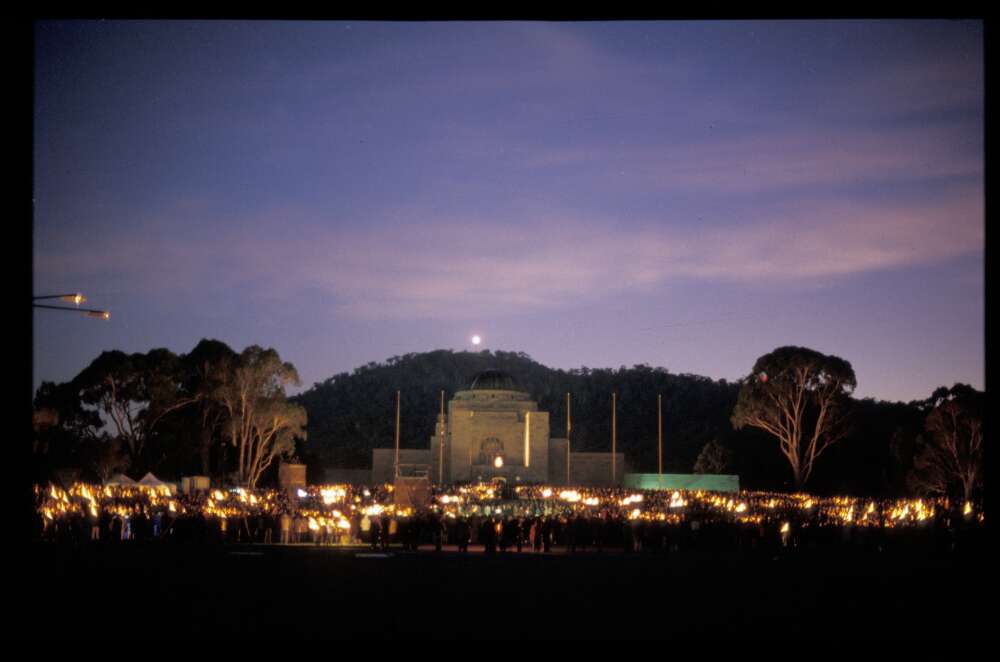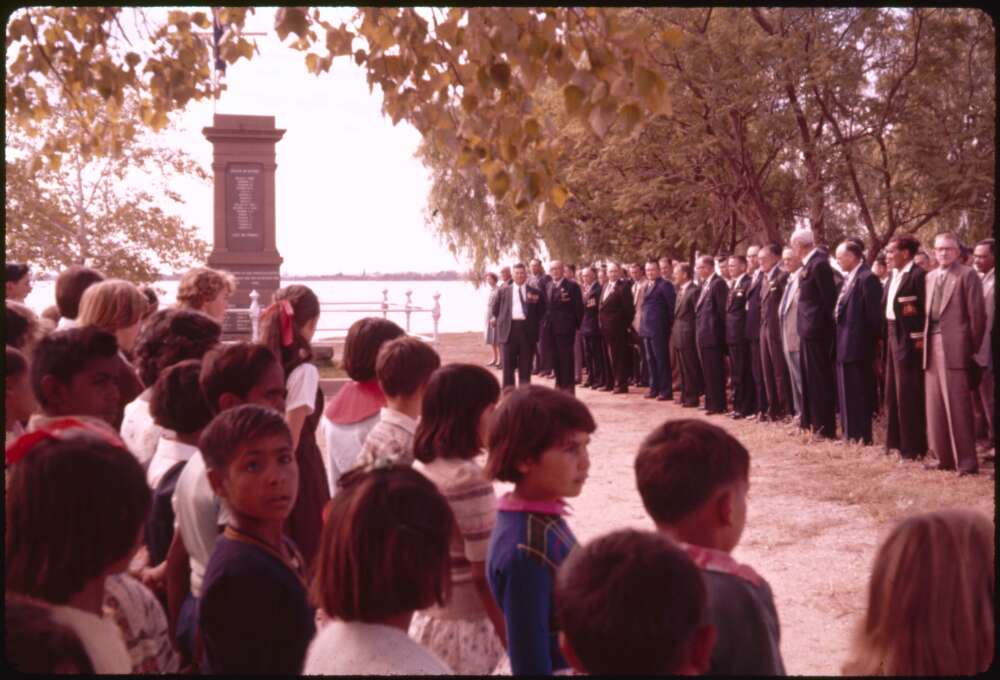The way we mark Anzac Day is always, at least a little bit different each year. The differences in these commemorative activities can usually tell us something important about the society of the time.

Loui Seselja, Anzac Day Dawn Service, Australian War Memorial, Canberra, 25 April 2002, 2, nla.cat-vn1701943
Of course, Anzac Day 2020 has been conspicuously different due to the scale of the public health situation we face across the globe, seeing campaigns such as the Australian War Memorial’s #AnzacAtHome, and RSL Branches’ #STANDTO and #lightupthedawn emerge in response.
Marking the day in schools has always been a bit different, too. Since the late 1920s, Anzac Day has been a public holiday in each state and territory, and these days the 25th often falls during the April school holidays. This has meant that commemorative activities in schools sometimes happen before or after the day itself, and that students and teachers engage with local ceremonies and marches, memorials, cenotaphs, RSLs, associations, veterans and service members in a huge variety of ways. This is even more the case at the moment with the move from face-to-face to remote learning in response to the pandemic.

Phil Wilding, Students from Murrin Bridge Aboriginal School at the Lake Cargelligo cenotaph for ANZAC Day, New South Wales, 25 April, 1960, nla.cat-vn4603419
Aside from commemorative activities, the First World War also makes up an important part of Australian Curriculum: History for Year 9 students.
While the National Library might not be the first institution to come to mind when planning lesson content about the First World War, our significant collections can put Australia’s experience of the war into its proper global context, and shed light on the personal stories of the home front. How did Australia’s military contribution fit into the war’s global narrative? How do we know about the conditions ordinary Australians faced during ‘total war’?
The content I have chosen to highlight below is easily accessible from schools and remote classrooms (whatever shape they take), and in many cases is designed specifically for teachers and students.
Teaching the First World War: Webinar Recording
This webinar recording features National Library education specialists and reference librarians. It introduces a variety of resources and strategies for using our First World War collections to engage students and enrich lesson content. A great place to start.
Digital Classroom Module: World War I
This resource features a variety of primary sources from the Library’s collection, taking cues from Dr Martin Woods’ NLA Publishing book Where Are Our Boys? How Newsmaps Won the Great War. It also contains features material on conscription, and historian interviews about commemoration, and the experiences of Australians across the four-year conflict.
Writing the Great War: personal stories to contemporary history
This seminar held at the Library in 2015, explored how Australians responded to the First World War through writing. From eyewitness accounts of journalists, soldiers and nurses, and a century of creative responses of poets and novelists, through to the historical interpretations of the event, the first great conflict engaged in by literate populations around the globe left an incredible written legacy.
The audio recordings of each presentation, and a full transcript of the event, make this a very useful collection of secondary source material.
A particular highlight for me is Professor Joan Beaumont’s contribution, where she speaks beautifully about the historiography of the First World War:
…writing about Australia's history of the Great War has been shaped and continues to be shaped not simply by the events of the past but by the events and values of the present. And this is not just because historians always face the problem of how to fill and find the missing pieces of jigsaws but because we know, that is unless we’re going to write chronicles we have to be selective, is an inherent part of any historical writing and indeed of any individual writing ... And so in making choices about what to include or exclude all writers are inevitably the prisoner of their own values and prejudices. But if our choices are driven too much by what sells, of what will make good television programs then we are at risk of engaging not in history but in memory which is a related but very different phenomenon.
The crucial differences between history, memory, remembrance, and commemoration are also explored in the Digital Classroom module above.
On War series
This lecture series from 2017 was presented in association with the Canberra Great War Study Group, the Estaminet and features some of Australia’s most respected First World War historians. It covers topics including the first conscription referendum, the Commonwealth War Graves Commission, the first battle of Bullecourt, the capture of Chipilly Spur, Military Geologists in the First World War, and the battle of Pozières.
Again, this series is provided as audio recordings with full transcripts to bring these content experts, and their research, directly to teachers and students.
Keepsakes: Australians and the Great War
This exhibition opened at the Library in late 2014 to mark the centenary of the conflict. While the show is long closed, all the material that formed it came from the National Library of Australia’s collection, where it is still carefully preserved for the future. This means that the Trove lists of objects displayed as part of the show, and National Library Director of Exhibitions, Dr Guy Hansen’s exhibition essay remain valuable resources.
Have a question about teaching the First World War using our collection? Get in touch!
We are here to help. Our educators are not the experts on your teaching methods or your students, but they do have a very good handle on what’s in the Library’s collection, how to find and access it, and how it connects with the curriculum.
Ask us your question about teaching the First World War on social media (Twitter or Instagram DM or message us through our Facebook page). We’ll respond to the top five in a follow up post shortly.